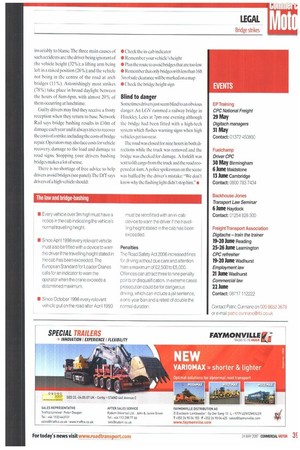Are you sure that
Page 38

Page 39

If you've noticed an error in this article please click here to report it so we can fix it.
it's going to fit?
Bridge suikes now attract tougher pena[ties
with the possibili-ty of
a heavier fine and a driving ban. But why do those hits keep on coming? Patric
Cunnane reports.
Bridge strikes by vehicles must be among the most avoidable of accidents,yet there are about 3,600 incidents in Britain every year. Since most of these involve railway bridges, the possibility of damage leading to a fatal derailment by an oncoming train should not be underestimated.
Strikes also carry the risk of injury to other road users, and at the very least there will be delays and diversions while the road is cleared and the bridge is made safe.
Tougher penalties
Last year's Road Safety Act introduced tougher penalties for driving without due care and attention, the offence under which bridge strikes are likely to be prosecuted, with fines of up to £5,000 and three to nine penalty points or disqualification. Tough penalties are needed. In the four years between 1996 and 2000 the rate of bridge strikes almost doubled to 2,000a year and it has kept climbing since — the Department for Transport says there are now an average of 10 strikes a day — and some of these incidents kill the driver.
Bridges usually carry a warning of their height; according to Network Rail the driver is invariably to blame. The three main causes of such accidents are: the driver being ignorant of the vehicle height (32%); a lifting arm being left in a raised position (26%); arid the vehicle not being in the centre of the road at arch bridges (11%). Astonishingly most strikes (78%) take place in broad daylight between the hours of Sam-6pm, with almost 20% of them occurring at lunchtime.
Guilty drivers may find they receive a frosty reception when they return to base. Network Rail says bridge bashing results in £10m of damage each year and it always tries to recover the costs of a strike, including the costs of bridge repair. Operators may also face costs for vehicle recovery, damage to the load and damage to road signs. Stopping your drivers bashing bridges makes a lot of sense.
There is no shortage of free advice to help drivers avoid bridges (see panel).The DfT says drivers of a high vehicle should: • Check the in-cab indicator • Remember your vehicle's height • Plan the route to avoid bridges that are too low • Remember that onl■,,bridges with less than 16ft 3in of safe clearance will he marked on a map • Check the bridge height sign
Blind to danger
Sometimes drivers just seem blind to an obvious danger. An LGV rammed a railway bridge in Hinckley, Leics at 7pm one evening although the bridge had been fitted with a high-tech system which flashes warning signs when high vehicles get too near.
'The road was closed for nine hours in both directions while the truck was removed and the bridge was checked for damage. A forklift was sent to lift cargo from the truck and the road reopened at 4am. A police spokesman on the scene was baffled by the driver's mistake: "We don't know why the flashing light didn't stop him." •






















































































































































































